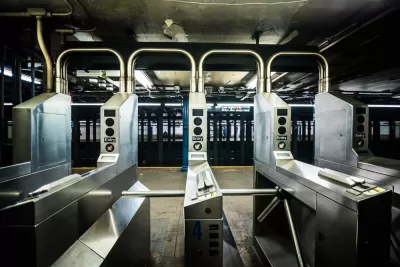In the continuing debate over congestion pricing in New York, Adele Peters asks if transit advocates are stopping short of what they should be asking for: free transit for all of New York.

It's been a rough year for the MTA. Between service failures and falling ridership, many are looking for a way to buoy public transit in New York. Some transit proponents have argued for congestion pricing, but Mayor Bill de Blasio continues to oppose the idea.
"But a report at the time, commissioned by mass transit advocate Theodore Kheel, suggested that a fee on drivers would not only reduce traffic and save the city billions by regaining the productivity of people previously stuck in gridlock, but would be able to pay for free public transportation for everyone else," Adele Peters writes for Fast Company. This is beyond what some have asked for. "The fees could help repair and upgrade the city’s struggling subway system. The idea of free public transit is less likely to ever happen," Peters writes. But that is what Mayor Bloomberg described wanting when he discussed the idea during his term.
For his part, de Blasio suggests funds for the MTA could come from a "millionaire's tax" that would subsidize transit passes for those who can’t afford tickets, Peters reports. But this system would do nothing to curb traffic or creates incentives for transit before the improvements can be made. Peters argues that transit's role will be just as important in the future: "Even if cars are shared, electric, and self-driving, subways and buses still have advantages, including keeping roads less congested. Cities will need to find ways to make those traditional services competitive, and that might eventually mean lower–or even free–fares."
FULL STORY: Should Public Transit Be Free?

Planetizen Federal Action Tracker
A weekly monitor of how Trump’s orders and actions are impacting planners and planning in America.

Congressman Proposes Bill to Rename DC Metro “Trump Train”
The Make Autorail Great Again Act would withhold federal funding to the system until the Washington Metropolitan Area Transit Authority (WMATA), rebrands as the Washington Metropolitan Authority for Greater Access (WMAGA).

The Simple Legislative Tool Transforming Vacant Downtowns
In California, Michigan and Georgia, an easy win is bringing dollars — and delight — back to city centers.

The States Losing Rural Delivery Rooms at an Alarming Pace
In some states, as few as 9% of rural hospitals still deliver babies. As a result, rising pre-term births, no adequate pre-term care and "harrowing" close calls are a growing reality.

The Small South Asian Republic Going all in on EVs
Thanks to one simple policy change less than five years ago, 65% of new cars in this Himalayan country are now electric.

DC Backpedals on Bike Lane Protection, Swaps Barriers for Paint
Citing aesthetic concerns, the city is removing the concrete barriers and flexposts that once separated Arizona Avenue cyclists from motor vehicles.
Urban Design for Planners 1: Software Tools
This six-course series explores essential urban design concepts using open source software and equips planners with the tools they need to participate fully in the urban design process.
Planning for Universal Design
Learn the tools for implementing Universal Design in planning regulations.
Smith Gee Studio
City of Charlotte
City of Camden Redevelopment Agency
City of Astoria
Transportation Research & Education Center (TREC) at Portland State University
US High Speed Rail Association
City of Camden Redevelopment Agency
Municipality of Princeton (NJ)




























